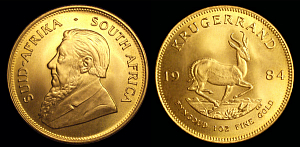
By David Liechty
The South African Krugerrand is an excellent choice for investors looking to maximize the value of their gold investment purchase. As one of the most common coins on the market, it is in relatively plentiful supply, and with a relatively lower overall demand for this coin compared to certain others, it trades at a fairly low premium. This translates into more gold for your money.
For example, compared to the U.S. Gold Eagle, which shares the same weight, fineness, and dimensions, the Krugerrand trades at a lower premium. Under current market conditions, and at a current spot price of $1,359.40, a one-ounce Krugerrand sells for approximately $1,435.25, or 5.6% over spot, and a one-ounce Gold Eagle sells for approximately $1,460.57, or 7.4% over spot. As an additional contrast, shares in the gold and silver-based Central Fund of Canada trade at a 9.2% premium over net asset value. Krugerrands are a relatively good value for their gold content.
Krugerrands are 22 karat coins and contain one full troy ounce of gold (33.93 grams, or 91.67% by weight) and a small amount of copper (2.826 grams, or 8.33% by weight). This gold/copper blend lends durability to the coins for circulation, and makes them an excellent choice for investors. The coins’ durability makes them more resistant to scratches and dents that can lower their resale value. Softer 24 karat (99.9% pure) coins are more prone to this, and must be handled with much more care. Since the purchase price and resale value of the coin only reflects the gold content, there is no real disadvantage to purchasing a coin that is less than 22 karat
Krugerrands are minted in full-ounce versions and half-, quarter-, and tenth-ounce coins. One advantage to these coins is the ease with which their approximate value can be ascertained. International spot prices are given in terms of a full troy ounce, and reference to this will give you an approximation of the amount you could realize from a one-ounce coin’s sale.
Krugerrands were first minted in 1967 and have been continually minted since that time. They have been present in the United States’ secondary coin market since 1974, although during certain apartheid years South Africa was banned from selling new coins in the U.S. The coin bears the profile of Paul Kruger, the first Boer president of the South African Republic, and a springbok, which is a national symbol of South Africa.
To recap on the Krugerrand:
Advantages: Relatively low premium, higher durability, very good liquidity, “standard” weight.
Disadvantages: Premium is not as low as certain other coins
Related Reading:
Krugerrand
Wikipedia

